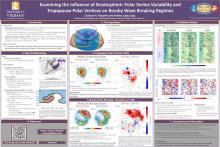Examining the Influence of Stratospheric Polar Vortex Variability and Tropopause Polar Vortices on Rossby Wave Breaking Regimes
Cameron
Paquette
Atmospheric & Environmental Sciences, University at Albany, SUNY
Poster
Variability in the high-latitude wintertime stratosphere is known to influence the tropospheric flow and Rossby wave dynamics on subseasonal-to-seasonal (S2S) timescales. In particular, stratospheric variability has been linked to shifts in Rossby wave breaking regimes which can precede persistent high-latitude blocking patterns. This analysis focuses on these impacts near the dynamic tropopause during periods of high stratospheric variability. The analysis first considers the influence of stratospheric variability on the high-latitude tropopause features known tropopause polar vortices (TPVs). TPVs are long-lived, (i.e., weeks), tropopause-based cyclonic features are known to initiate cyclogenesis and influence the extratropical jet stream. Given the S2S timescales of both the TPV lifespans and high-latitude stratospheric variability, the interaction between the two phenomena is hypothesized to represent a potential pathway for shifts in Rossby wave breaking regimes.
The second part of the analysis explores and considers the mechanisms by which the anomalous stratospheric flow influences shifts in Rossby wave breaking regimes, through the added consideration of the associated variability in TPVs. To quantify this relationship, a robust TPV tracking algorithm was applied to ERA-Interim wind and temperature data between 1979-2017. During the same period, the strength of the winter-time stratospheric polar vortex was defined by the daily and zonally-averaged 10-hPa zonal winds at 60oN. TPVs were then categorized as occurring during extremely strong (>90% percentile), extremely weak (<10% percentile) and neutral (45–55% percentile) stratospheric polar vortex conditions. A Rossby wave breaking detection algorithm is employed to establish how variability in stratospheric flow and TPVs are connected to anomalous wave breaking conditions near the tropopause. This algorithm identifies potential vorticity streamers, overturns, and cutoffs, and can track the progression of wave breaking through time and space. The results show how variations in stratospheric flow promote shifts in the type, location, and frequency of Rossby wave breaking regimes, and we partition these results to build an understanding of the role of TPVs in initiating or amplifying the occurrence of Rossby wave breaking.
The second part of the analysis explores and considers the mechanisms by which the anomalous stratospheric flow influences shifts in Rossby wave breaking regimes, through the added consideration of the associated variability in TPVs. To quantify this relationship, a robust TPV tracking algorithm was applied to ERA-Interim wind and temperature data between 1979-2017. During the same period, the strength of the winter-time stratospheric polar vortex was defined by the daily and zonally-averaged 10-hPa zonal winds at 60oN. TPVs were then categorized as occurring during extremely strong (>90% percentile), extremely weak (<10% percentile) and neutral (45–55% percentile) stratospheric polar vortex conditions. A Rossby wave breaking detection algorithm is employed to establish how variability in stratospheric flow and TPVs are connected to anomalous wave breaking conditions near the tropopause. This algorithm identifies potential vorticity streamers, overturns, and cutoffs, and can track the progression of wave breaking through time and space. The results show how variations in stratospheric flow promote shifts in the type, location, and frequency of Rossby wave breaking regimes, and we partition these results to build an understanding of the role of TPVs in initiating or amplifying the occurrence of Rossby wave breaking.

Poster file
paquette_cameron_blocking_poster.pdf
(2.85 MB)
Meeting homepage
